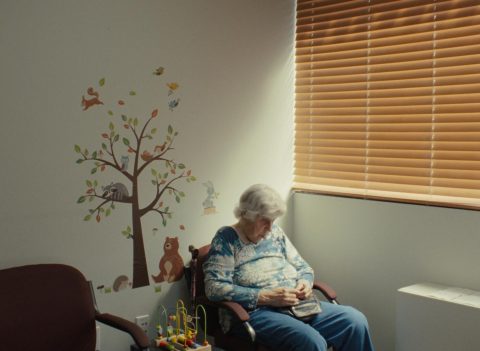Ruth (Marlene Jewell) is elderly, lives alone and shows signs of early dementia. Shannon (Katie Mattattal) her pregnant, much-younger caregiver, also appears to be getting lost inside of herself, but for another reason: the father of her unborn child has bailed. Heather Young’s wonderful second feature There, There (2024) watches these two women at different points in their lives forge a bond while experiencing their own uniquely crushing loneliness and abandonment.
Like Murmur (2019), Young’s debut concerning a recovering alcoholic who starts adopting too many animals from the shelter, the focus is on ordinary, lonely people, desperate for warmth and connection. The characters in her films, played mostly by non-actors, could be anyone you know — an aunt, a sister, a co-worker — and the director displays a knack for compiling mundane daily activities and forming them into compelling character studies with unexpected narrative arcs.
There, There quietly observes Ruth’s mental deterioration during the small window of time in which a person with dementia goes from being moderately self-sufficient to needing a permanent care facility. For instance, when we meet Ruth preparing a loaf of bread for her beloved pigeons, she’s still slicing it up into measured, symmetrical cubes. Later, as her mind wanders, the slices become a bit haphazard, indicating things are getting worse.
Young emphasises how lifelines are vital for anyone struggling with isolation and loneliness. For Ruth, her trip to the convenience store is the only time she interacts with someone besides her caregiver, and the act of buying bread and feeding the pigeons gives her companionship and a sense of purpose. Shannon, on the other hand, has the luxury of living with a friend, who, despite being a bit vain and permanently glued to the phone, still offers some companionship. Both of these lifelines eventually disappear, threatening to plunge both characters deeper into despair.
There, There handles Shannon’s storyline with her emotionally absent friend with the utmost respect, never judging the other young woman for not being there. It’s an understated reminder of that feeling of disappointment that comes with finding out your friend perhaps wasn’t as ride-or-die as you once hoped, done without histrionics but with realistic conversation. It’s hard to watch Shannon learn that other people’s actions will let you down sometimes and anyone who’s experienced that IRL will feel the sting.
Like Murmur, Young shoots in a 4:3 aspect ratio, giving it a documentary feel that’s both cold and intimate, and the director’s a natural at composing striking shots, even when a subject’s just doing the laundry or looking at their phone. There, There’s slow rhythm and sparse dialogue might take some viewers a moment to settle into — a lot of this is just witnessing two people going about their quiet daily lives — but once they do they’ll find a film filled with insight and compassion, especially in the final stretch.
I can imagine what you’re anticipating: a story centred on a senior grappling with dementia and a caregiver with a newborn will inevitably culminate with some sort of corny cycle-of-life cliche, where the elderly woman passes away and the baby serves as a symbol of hope, renewal and life carrying on. Young avoids that easy, sentimental route we’ve seen in so many other films with similar concerns. It’s a difficult movie to ‘spoil,’ but something truly beautiful unfolds in the final act. I don’t want to reveal the clever and tender way this seemingly bleak story of loneliness and abandonment comes together. To sum it up: the simple acts of giving and receiving care can save us from disappearing into ourselves.
Editor-at-large Jared loves movies and lives with Kiki in Berlin.

